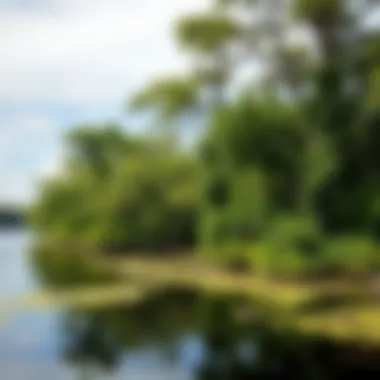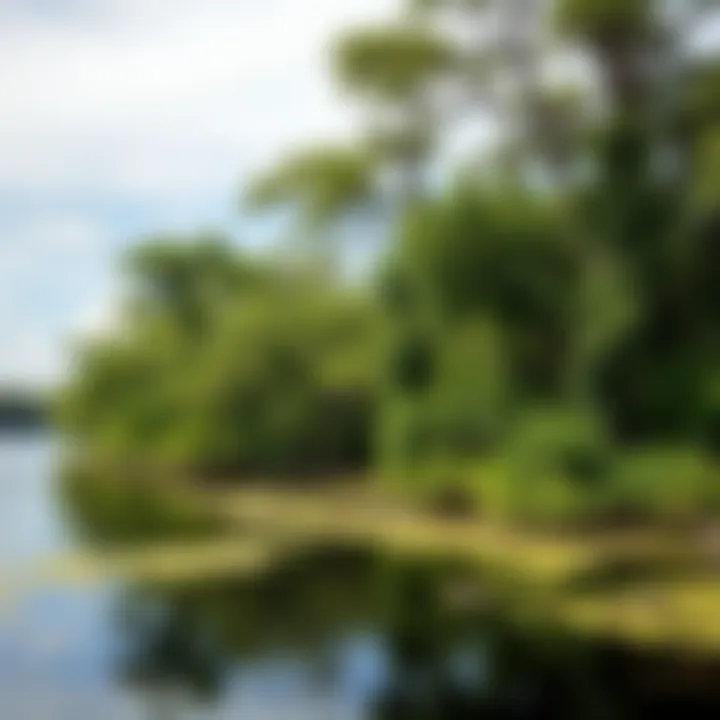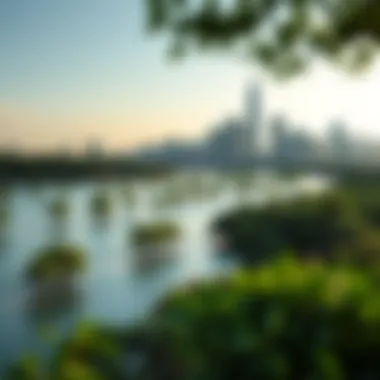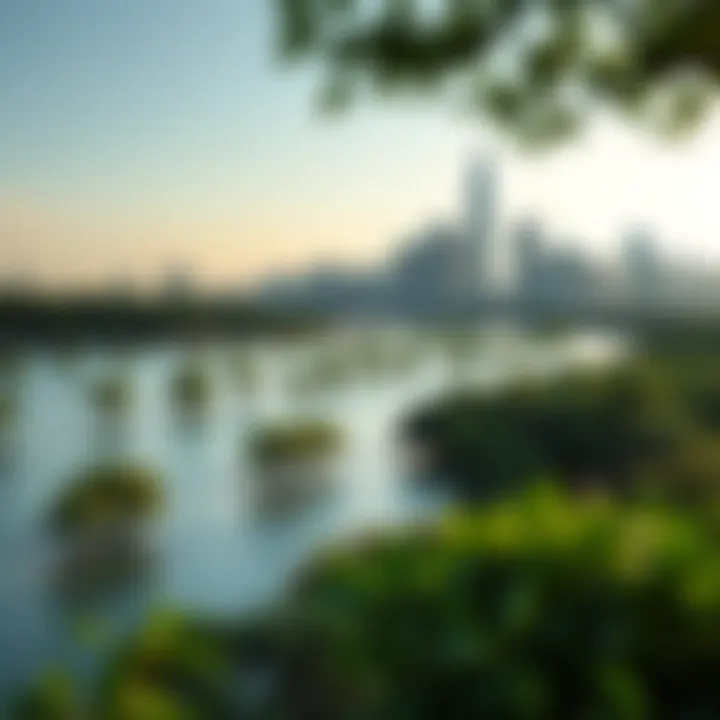Exploring Mangrove Parks: Nature Meets Urban Growth


Intro
Mangrove parks represent a unique blend of ecological resilience and urban development, acting as green lungs in our ever-expanding cities. These coastal ecosystems serve not only as a bastion for biodiversity but also contribute to the social fabric and economic vitality of urban areas. Given the ongoing pressures of urbanization, understanding the importance of mangrove parks becomes crucial—especially for those eyeing homeownership, new investments, or aspiring to enhance community living.
As we untangle the complex web that binds nature and development, a key player emerges: the mangrove parks. This article invites readers—homebuyers, investors, agents, developers, and expatriates—to delve deeply into the myriad advantages that these natural havens offer, from ecological benefits to opportunities for sustainable business development.
With an emphasis on thorough analysis and case studies from around the globe, we will see how mangrove parks not only offer serene landscapes for recreational activities but also act as future-ready investment spots. Their role in fostering community engagement and enhancing urban biodiversity cannot be understated, providing a compelling reason to consider integration with real estate strategies.
Together, we’ll navigate through several key insights about current market trends, investment prospects, and the undeniable symbiotic relationship between natural environments and urban planning. Let's explore the interdependencies that nurture both our green spaces and the communities that thrive around them.
Preface to Mangrove Parks
Exploring the multifaceted world of mangrove parks unveils a rich tapestry where nature entwines with urban development. These unique ecosystems serve as critical environmental buffers and social hubs, catalyzing community engagement while providing invaluable ecological services. As urban areas expand and the pressure on natural resources intensifies, understanding mangrove parks becomes ever more vital. From the perspective of investors, homebuyers, and real estate professionals, the presence of mangrove parks not only enhances property appeal but also signals a commitment to sustainability and ecological stewardship.
Defining Mangrove Ecosystems
Mangrove ecosystems are coastal vegetative communities comprised of salt-tolerant trees and shrubs that thrive along tropical and subtropical shorelines. They typically occupy intertidal zones where salt and freshwater mingle. These complex systems are a cacophony of life, home to a vast range of species, including fish, birds, and crustaceans. Their roots provide structural support and serve as nurseries for many marine species, illustrating why they’re deemed vital for coastal biodiversity.
Key characteristics of mangrove ecosystems include:
- Resistance to saline environments, enabling growth in salty waters
- Root structures that stabilize soil and reduce coastal erosion
- A unique biota, fostering high levels of biodiversity
Often described as a 'buffer zone,' mangrove forests absorb storm surges, acting as a frontline defense against extreme weather events. They play a critical role in maintaining the balance of coastal ecosystems, which is essential in mitigating climate change effects. A healthy mangrove ecosystem can also adapt and thrive in changing habitats, showing resilience in the face of environmental shifts.
Importance of Mangrove Parks
The importance of mangrove parks extends beyond their ecological functions; they’re vital for social and economic aspects too. These areas impact local communities, global biodiversity, and urban landscapes, creating a holistic environment that nurtures life and prosperity.
Several key contributions of mangrove parks include:
- Climate Regulation: As natural carbon sinks, mangroves sequester significant amounts of carbon dioxide, helping to lessen the effects of climate change.
- Enhanced Water Quality: The dense root systems filter pollutants and sediments, improving the quality of water that flows through coastal areas.
- Economic Benefits: Local economies can thrive on tourism, fishing, and conservation activities, all of which can be centered around these parks. Communities gain not only from the resources available but also from the aesthetic and recreational spaces that enhance quality of life.
- Biodiversity Preservation: These ecosystems provide habitat for countless species, contributing to overall biodiversity. They act as breeding grounds for various marine life, ensuring the sustainability of fish populations vital to local fisheries.
In essence, the significance of Mangrove parks can’t be overstated. They weave together ecological integrity, economic viability, and social wellbeing, making them indispensable assets in any urban planning strategy.
"Marine ecosystems such as mangroves hold a wealth of opportunities, not just for environmental sustainability but also for community empowerment and enriched living spaces."
Understanding the essence of mangrove parks is a stepping stone for stakeholders, investors, and developers. Their integration into urban development plans can lead to enhanced community cohesion and a thriving ecosystem, showcasing the seamless interplay between nature and human advancement.
Ecological Significance
Exploring the ecological significance of mangrove parks is crucial in understanding how these unique ecosystems function and benefit both the environment and human activities. By delving into the intricate relationships within these habitats, we gain insights into their roles in supporting biodiversity, mitigating climate change, and improving water quality.
Biodiversity and Habitat
Mangrove parks serve as invaluable sanctuaries for a myriad of species. They are home to countless organisms, which range from fish and crabs to birds and insects. The complex root systems of mangroves create a nursery-like environment that supports juvenile marine creatures. Here, species like the mangrove snapper and juvenile tarpon find refuge from predators and abundant food sources.
This biodiversity contributes significantly to the overall health of marine ecosystems, as well. A diverse habitat ensures the resilience of species against changing conditions, which can be especially important in a world where climate change looms large. Additionally, these parks provide essential stopover points for migratory birds, connecting different ecosystems and facilitating genetic exchanges that promote healthier populations.
"Biodiversity is the cornerstone of a stable ecosystem; mangroves illustrate this beautifully."
Carbon Sequestration
Mangrove forests are remarkably efficient at sequestering carbon. The sediment accumulated in their roots stores carbon dioxide, a greenhouse gas that greatly contributes to climate change. Estimates suggest that mangrove forests can store up to three to five times more carbon per hectare than tropical rainforests. This capacity for carbon storage makes them essential in lowering global carbon emissions.


One might visualize a mangrove park as a natural carbon sink—a sponge that absorbs excess carbon from the atmosphere. By protecting and restoring mangrove habitats, we can enhance their role as buffers against climate change, thus supporting global sustainability efforts. Investors and developers increasingly recognize this potential, adding another layer of justification for mangrove conservation within urban planning initiatives.
Water Quality Improvement
Water quality is another area where mangrove parks excel. Their unique structure naturally filters pollutants and sediments from the water. The dense root systems trap and stabilize soil, reducing erosion and preventing runoff from entering adjacent marine environments. This process not only protects water quality but also ensures that the surrounding coral reefs remain healthy and vibrant.
Moreover, mangroves play a role in nutrient cycling, providing essential elements for the growth of other marine life. When organic matter decomposes within these ecosystems, it enriches the water column, supporting a diverse food web. For homebuyers and developers interested in sustainable living, living near well-maintained mangrove parks can enhance property values and quality of life, while simultaneously promoting the environment.
The role of mangrove parks in providing ecological balance emphasizes the need for preserving these unique natural resources amid urban development. As we navigate our relationship with nature, understanding their ecological significance can guide sustainable practices that benefit both economic growth and environmental stewardship.
Socio-Economic Contributions
The socio-economic contributions of mangrove parks reveal how these ecosystems can be tangible assets rather than merely scenic backdrops. They serve as bridges connecting nature and community needs while enhancing urban living. In bustling cities, where the concrete jungle can feel overwhelmingly sterile, mangrove parks offer a much-needed breath of fresh air. Their benefits preferentially touch on areas like tourism, local employment, and the overall enhancement of community wellbeing. Understanding this intersection helps investors, homebuyers, and developers appreciate the holistic value of these parks.
Tourism and Recreation
Tourism in regions with mangrove parks is not just a secondary perk but a primary draw. Visitors flock to explore the rich biodiversity found within these ecosystems. From kayaking through winding waterways to participating in guided nature walks, recreational opportunities abound. Tourists are often on the lookout for authentic experiences, and mangrove parks provide those in spades. They become sanctuaries where one can disconnect from the hustle of city life while still being within reach of urban amenities.
Moreover, local businesses thrive amidst this influx of tourists. Restaurants featuring fresh seafood, shops selling handmade goods, and eco-tour companies benefit directly from an increase in foot traffic. This tourism boost can elevate the entire local economy, creating a ripple effect that enriches the community. For investors, the appeal of mangrove parks as prime tourism spots can translate into favorable real estate trends, as well-maintained public spaces often bolster property values.
"Investing in natural assets like mangrove parks signifies a shift towards more sustainable and lucrative development that benefits everyone involved."
Local Employment Opportunities
Local employment opportunities quite often spring up in and around mangrove parks. With the increase in tourism and recreational activities, there arises a need for skilled personnel to manage these ventures. Positions range from park rangers and tour guides to hospitality staff in nearby hotels. These roles are vital, contributing significantly to the socio-economic fabric of the community.
Additionally, local artisans and craftspeople find new avenues for income through the establishment of markets and fairs that showcase their work to tourists and locals alike. This exchange not only provides their crafts a platform but also creates a sense of pride within the community. As a result, residential areas close to mangrove parks become attractive for those seeking job opportunities that align with both their professional and personal values.
In summary, by fostering both tourism and employment, mangrove parks link the health of the ecosystem with the prosperity of local communities. This interconnectedness underscores the relevance of integrating these green spaces into urban planning as a strategy to cultivate economic growth and foster community resilience.
Mangrove Parks and Urban Development
Mangrove parks are not merely patches of greenery amidst urban chaos; they represent a critical bridge between nature and the sprawling concrete jungles we inhabit. Their integration into urban development plans offers myriad benefits that enhance both ecological balance and societal well-being. In today’s world, where urbanization is rampant, recognizing the value of mangrove parks becomes essential for sustainable growth. They not only bolster biodiversity but also provide significant economic contributions, improve the quality of life, and increase the resilience of coastal cities against climate change.
Integration with Urban Planning
The integration of mangrove parks within urban planning is a vital aspect of modern city development. With rapid urban expansion, city planners face the challenge of accommodating human needs while preserving vital ecosystems. Mangrove parks can seamlessly blend these demands.
These parks serve as natural buffers against storms, offering protection to coastal neighborhoods from flooding and rising sea levels. A well-thought-out mangrove park can mitigate storm surges and protect infrastructure, saving cities a substantial amount in disaster management costs. In addition to environmental protection, such parks foster recreational activities and enhance property values, appealing greatly to potential homebuyers and investors alike.
Factors to consider when integrating mangrove parks include:
- Land Use Zoning: Allocating spaces specifically for mangrove conservation without conflicting with development interests.
- Community Involvement: Engaging local communities in the planning process ensures that the parks meet the needs and cultural values of residents.
- Sustainable Practices: Implementing eco-friendly practices during development minimizes ecological footprints and upholds the essence of mangrove habitats.
Adopting these strategies can lead to more resilient and attractive urban environments, ultimately benefiting residents, developers, and the ecosystem.
Case Studies in Dubai
Dubai, known for its ambitious urban projects, is an excellent case in point when examining the integration of mangrove parks in urban settings. The city’s approach has not only emphasized luxury and living spaces but has also prioritized environmental sustainability. One notable example is the Dubai Mangrove Forest project, which aims to expand and preserve mangrove ecosystems along the coastline while creating a recreational hotspot for the community.
This project showcases how carefully planned urban developments can coexist with natural habitats. By creating accessible walkways, observation decks, and educational centers, Dubai has turned mangroves into a vital component of the urban landscape.
The benefits seen from such initiatives include:


- Boosting Ecotourism: With the addition of well-maintained parks, visitors flock to observe local wildlife, which enhances the local economy.
- Raising Environmental Awareness: Educational programs within these parks engage citizens and tourists, fostering a culture of conservation.
- Creating Green Jobs: The maintenance and promotion of such parks lead to new employment opportunities in eco-tourism and conservation.
"Mangrove parks in urban environments are crucial. They enhance biodiversity, protect our coastlines, and contribute to the overall urban ecosystem services."
By examining Dubai’s unique efforts, other cities can learn the importance of preserving natural elements within their growing urban landscapes. As cities expand, integrating mangrove parks becomes essential in striking a balance between development and environmental sustainability.
Community Engagement
Community engagement plays a pivotal role in harnessing the full potential of mangrove parks. It is not just about preserving these ecosystems; it’s about creating a strong connection between residents and their natural surroundings. When communities develop a vested interest in their local mangrove areas, they become stewards of the environment, fostering not only ecological health but also social welfare.
Public Awareness Initiatives
Public awareness initiatives are essential for building a bridge between the mangrove parks and the people who inhabit the surrounding areas. These programs are designed to inform the public about the ecological benefits of mangroves, such as their role in carbon sequestration and biodiversity conservation.
- Workshops and Seminars: Local governments and environmental groups often conduct workshops to educate the community on the importance of mangroves. For instance, in cities like Miami, sessions focus on the impact of mangrove ecosystems on local weather patterns, guiding informed conversations about climate change.
- Awareness Campaigns: Using various media outlets, from social media to local news, authorities can share compelling stories that highlight the economic and environmental advantages of maintaining these parks. For example, visual storytelling showcasing the wildlife that thrives in these habitats can engage viewers and promote interest.
- Collaboration with Schools: Integrating mangrove studies into school curriculum helps foster a new generation of conservationists. Projects can involve students in active research and restoration efforts, such as planting initiatives, allowing them to feel directly tied to their local environment.
By making information accessible, communities can collectively appreciate the integral role mangrove parks play in their surroundings.
Volunteer Programs
Volunteer programs form the backbone of community engagement in mangrove parks. These initiatives empower individuals to take action, whether through clean-up efforts, planting new saplings, or participating in wildlife surveys.
- Local Engagement: Programs designed to involve local citizens can significantly enhance community ownership of the mangrove ecosystem. For example, in Malaysia, volunteers participate in guided tours of mangrove restoration sites, yielding immediate opportunities to learn while contributing to the cause.
- Corporate Partnerships: Local businesses often team up with environmental agencies to organize corporate volunteer days. Employees from companies can engage in projects, fostering team spirit while helping the environment. This not only yields physical benefits in terms of planted trees but also promotes corporate responsibility within the community.
- Annual Events: Organizing events such as "Mangrove Day" for locals can galvanize interest and involvement. Activities can include educational talks, guided nature walks, and family-friendly activities that tie back to the importance of mangroves.
Through these volunteer programs, individuals step off the sidelines and become active participants in environmental stewardship, forging stronger community ties while simultaneously enhancing local mangrove habitats.
"The strength of a community lies in its ability to work together for common good; engaging with mangrove parks fosters both community unity and environmental resilience."
Taking these measures ensures that mangrove parks are seen not just as green spaces but as vital community resources that stand to benefit everyone.
Legal Framework and Policy
The intersection of legal frameworks and policy initiatives is crucial in the realm of mangrove parks. These spaces, often nestled within urban sprawls, work as natural titans that protect coastlines, serve as biodiversity hotspots, and enhance quality of life. To safeguard these vital ecosystems, appropriate regulations must be firmly in place. Without robust policies, the ecological and socio-economic benefits these parks offer could drastically diminish.
Regulations Governing Mangrove Conservation
Regulations governing mangrove conservation encompass a range of legal provisions aimed at protecting these vital ecosystems from degradation. These laws generally focus on minimizing human interference, curbing pollution, and fostering sustainable management practices.
Some important aspects of these regulations include:
- Zoning Laws: Defining areas where development is permissible and where it is not, ensuring that mangrove regions remain untouched by urban expansion.
- Protected Status: Many mangrove areas are designated as protected under national and international laws. This status not only preserves the habitat but also raises awareness about their ecological value.
- Restoration Mandates: Some regulations require developers to restore mangrove areas if they disturb them. This might entail planting new trees or ensuring that affected habitats are rehabilitated.
- Pollution Control Measurements: Regulations could enforce strict controls on waste disposal and agricultural runoff that may harm these sensitive areas.
Governments may often collaborate with environmental organizations to enforce these regulations, ensuring the health of mangrove ecosystems while actively engaging the community in conservation efforts. This collaborative approach helps maintain a delicate balance between economic interests and environmental stewardship.
Impact of Legislation on Development
Legislation can strongly influence how development projects unfold in areas hosting mangrove parks. Many stakeholders—including investors, developers, and public entities—must navigate and comprehend the legal landscape surrounding these natural areas. The impact of such legislation can vary, but some common influences include:
- Economic Incentives: Certain laws provide tax breaks or incentives for developers who incorporate green spaces, such as mangrove parks, into their projects. This often encourages a trend towards eco-friendly development.
- Project Delays: Regulatory compliance checkpoints can cause delay in project timelines. While this may frustrate some developers, these measures ensure environmental due diligence and strengthen protection efforts.
- Increased Property Value: Many buyers today look favorably upon properties near green spaces like mangrove parks. The presence of conservation legislation can bolster property values, as it denotes a commitment to preserving the natural habitat.
- Public Scrutiny and Engagement: Legislation often invites public comment and engagement. This step provides communities a chance to voice their concerns, making developers more responsive to the needs and values of local inhabitants.
"Mangrove parks are not just a treasure of biodiversity; they embody a critical link between nature and sustainable urban development."
The future of mangrove parks hinges upon effective legal frameworks that not only protect these ecosystems but harmonize with urban growth. For more information on environmental regulations and practices related to mangrove conservation, visiting well-established sources like Wikipedias or Britannica can provide further insights.
Challenges Facing Mangrove Parks


As we navigate the complexities of urban development, the significance of mangrove parks cannot be overstated. These unique ecosystems face a multitude of challenges that threaten their existence and the benefits they provide. Understanding these challenges is not just essential for conservationists; it’s also a pivotal aspect for investors, homebuyers, agents, developers, and expatriates who want to be part of sustainable urban environments.
Climate Change Effects
Climate change poses a serious threat to mangrove parks around the world. Rising sea levels, driven by polar ice melt and thermal expansion of the ocean, can submerge these vital areas. Saltwater intrusion further complicates matters, as freshwater systems become compromised. The increased frequency and intensity of storms are additional risks that can devastate these delicate ecosystems.
- Impact on Biodiversity: The changes in salinity and hydrology affect not just the mangroves themselves, but also the rich biodiversity that relies on them as habitat. Species such as fish, birds, and various invertebrates are tightly linked to these ecosystems, and as their environment changes, so too does their ability to thrive.
- Carbon Storage Concerns: Mangroves are known for their ability to sequester carbon, making them crucial in the battle against climate change. However, when they are damaged or die due to climate impacts, this function is lost, releasing previously stored carbon back into the atmosphere.
Urban Encroachment
Urban development often encroaches upon mangrove parks, resulting in significant challenges. As cities expand, the need for land frequently leads to the reclamation of these vital areas, posing both environmental and economic repercussions.
- Loss of Natural Resources: When mangrove areas are replaced with concrete jungles, the natural resources they provide—like fisheries, timber, and tourism opportunities—are compromised. This loss can lead to economic decline in local communities that depend on these resources for their livelihood.
- Infrastructure Development Strain: With urban areas spreading like wildfire, the infrastructure needed to support them often overshadows the ecological importance of mangroves. Development projects can block natural water flows, disrupt habitats, and create sedimentation issues that impair mangrove growth.
In summary, the challenges facing mangrove parks are multi-faceted, intertwining ecological integrity with urban needs. Addressing these issues requires robust collaboration among policymakers, community members, and environmental advocates to ensure that these important ecosystems continue to thrive amidst the pressures of urbanization and climate change.
"The future of mangrove parks hinges on a collective effort to balance urban growth and environmental sustainability."
For those interested in the latest discussions and research, sites like Wikipedia provide extensive information on this subject, while forums like Reddit can offer community insights and advice.
Future Prospects for Mangrove Parks
As urban centers continue to expand, the future of mangrove parks takes on growing significance in our continual quest for sustainable development. These unique ecosystems not only contribute to biodiversity and climate resilience but also serve as essential green spaces in heavily urbanized areas. By understanding innovative preservation strategies and the valuable role mangrove parks can play in sustainable economic growth, investors, homebuyers, and developers gain insights into their true worth.
Innovative Preservation Strategies
Addressing preservation of mangrove parks involves a mix of traditional and modern approaches that rethink how these vital areas can thrive amid urban challenges. Local governments and organizations are crafting policies that promote collaboration among stakeholders. The key here is proactive engagement, with measures such as:
- Community-based conservation: Involving locals in the stewardship of mangroves cultivates a sense of ownership and responsibility. For instance, the initiative in Thailand where fishermen receive training on sustainable fishing methods has led to more prosperous mangrove ecosystems.
- Adaptive management: Tailoring preservation strategies to the specific characteristics of each mangrove area allows for more effective responses to potential threats like pollution or natural disasters. An adaptable framework enables continuous learning and improvement based on local conditions.
- Technological integration: Employing drones and remote sensing technologies aids in monitoring ecosystems and detecting changes. This tech-savvy approach enables more timely interventions and creates a bridge between high-tech solutions and environmental conservation.
These strategies underscore a crucial point: protecting mangrove parks doesn't solely depend on policies but on holistic community involvement and innovative techniques. As preservation efforts evolve, mangrove parks can potentially become vibrant ecosystems that withstand the test of time.
Role in Sustainable Growth
Mangrove parks lie at the crossroads of ecology and economy, acting as a vital cog in the wheel of sustainable growth. Their value extends beyond mere aesthetics; they play a pivotal role in several areas:
- Ecosystem services: Mangroves filter water, protect shorelines from erosion, and provide nursery grounds for various fish species. These services are invaluable, as they support local fisheries and tourism industries, which can, in turn, strengthen local economies.
- Carbon sequestration: Mangrove forests absorb significant amounts of carbon dioxide, making them essential in combating climate change. This ability can be marketed through carbon credits, drawing in investors seeking ethical and sustainable opportunities.
- Infrastructure resilience: Integrating mangrove parks into urban development plans can enhance city resilience against extreme weather events. These green buffers not only mitigate flooding but also improve air quality, enriching urban life.
As cities continue their developmental journeys, incorporating mangrove parks into strategic planning becomes imperative. They provide a pathway towards achieving economic viability while ensuring ecological integrity. This unique balance can entice investors looking toward the future, as embracing sustainable growth becomes not just an option but a necessity.
"Mangrove parks can serve as pivotal resources for communities, yielding economic benefits while preserving biodiversity and ecosystem services."
End
The intricate relationship between mangrove parks and urban development cannot be overstated. As nature’s fortress against coastal erosion and a crucial habitat for diverse species, mangrove parks present a unique blend of ecological value and developmental potential. The integration of these parks into urban planning yields numerous benefits: enhancing biodiversity, stabilizing shorelines, and improving water quality. These factors contribute not only to environmental health but also to the economic viability of urban spaces.
Summary of Findings
Mangrove parks serve as essential ecosystems that specifically aid in combating climate change effects while simultaneously offering social and economic advantages. This article has explored how they bolster local biodiversity by providing shelter and breeding grounds for various species. Additionally, their role in carbon sequestration is pivotal in mitigating greenhouse gas emissions. Parks also enhance community cohesion, providing spaces for recreation and engagement, thus elevating quality of life. Urban planners and local governments are beginning to acknowledge that incorporating these green spaces can lead to more sustainable urban environments.
Call to Action for Stakeholders
To truly capitalize on the potential of mangrove parks, stakeholders—including investors, homebuyers, agents, developers, and policymakers—must take proactive steps. Collaboration is key. Investors should recognize the long-term advantages of green spaces in urban development, not just for immediate returns. Homebuyers are encouraged to consider properties near these ecosystems, as they not only benefit from the natural beauty but also from enhanced living conditions. Agents should promote these unique features to elevate property value.
For developers, integrating mangrove parks into projects can be a win-win; it fosters regulatory compliance and enhances community goodwill. Lastly, community engagement is essential. The public must be made aware of the benefits and how they can participate in preserving these valuable ecosystems.
Investing in education and awareness programs can empower local populations to actively partake in the conservation efforts. The call to action is clear: all stakeholders must unite to protect and promote mangrove parks as invaluable assets for a sustainable future.
"The preservation of our environment is not merely a necessity; it is an investment in generations yet to come."
For more information on the significance of mangrove ecosystems, you can visit Wikipedia or explore case studies on global initiatives on Britannica.



